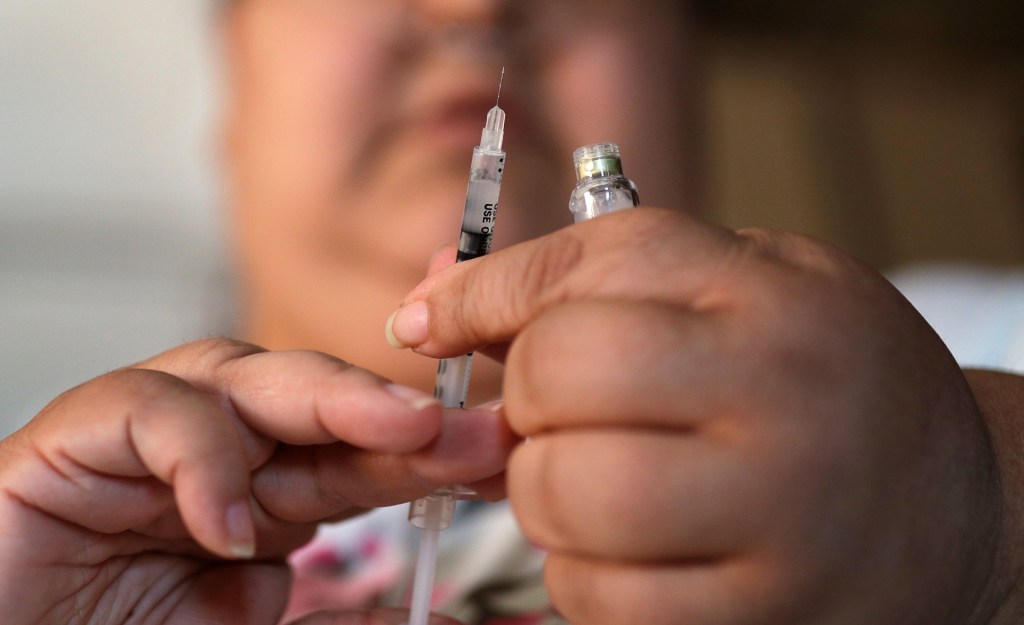Story at a glance
- President Biden included an insulin price cap within his Build Back Better Act, which passed the House back in November 2021.
- For those enrolled in Medicare and with private group or individual health insurance plans, the price of insulin would be capped at $35.
- Yet in 2020, about 28 million people in the U.S. did not have health insurance, which means the insulin price cap would not apply to them.
President Biden has attempted to control the skyrocketing costs associated with having diabetes by capping the amount drug companies can charge for insulin, but there are glaring loopholes in the plan that many Americans are criticizing.

In this April 18, 2017 file photo, a woman with Type 2 diabetes prepares to inject herself with insulin at her home in Las Vegas. John Locher/ AP
In November of last year, the House passed Biden’s Build Back Better Act (BBBA), which included provisions that would limit the cost of insulin to $35, but only for those under Medicare or for those with private group or individual health insurance plans.
The price capping is expected to lower out-of-pocket costs for insulin users, with GoodRx Health estimating the average price per dispenser or vial of insulin ranges from $63 to $363, prices varying by brand and dosage.
The Mayo Clinic also found that the most commonly used forms of analog insulin cost 10 times more in the U.S. than in any other developed country.
Though capping insulin prices seemed like the right solution, some Americans disagree, arguing BBBA ignores a significant portion of the country that doesn’t have health insurance and therefore would not qualify for the $35 price cutoff.
America is changing faster than ever! Add Changing America to your Facebook or Twitter feed to stay on top of the news.
Ginni Correa, a 27-year-old with type 1 diabetes in Florida, told The Guardian that, “it just seems like a big scam for the private insurance companies. Our lives are being used for propaganda. Wording is very important. Because when you tell the general public that you’re capping the price of insulin, that’s deceitful because millions of Americans aren’t insured and the majority of diabetics who are insured, they still can’t afford the cost and it’s going to go to the premiums.”
According to the latest Census Bureau data, in 2020 about 8 percent of people did not have health insurance at any point during the year, translating to about 28 million people. The agency also noted that those who worked less than full-time, year-round were less likely to be covered by private insurance in 2020 than in 2018, which is exactly the case for many people as the coronavirus pandemic began in spring 2020.
The pandemic caused thousands of people to become suddenly unemployed, with the Congressional Research Service conducting an analysis that found in April 2020 unemployment hit nearly 15 percent, the highest rate since 1948. By July 2021, unemployment still remained high at 5 percent.
“These are things that aren’t addressed when it comes to the Build Back Better plan and the $35 co-pay cap, because even if you are fortunate enough to have insurance at the time, insurance isn’t something that’s necessarily stable in this country,” said Correa to The Guardian.
Many employers offer private health insurance to their employees, so long as they stay actively employed. However, many hourly jobs don’t offer health insurance, with people left to decide if they can afford the coverage on their own.
Health insurance for those with diabetes can be consequential, as the American Action Forum, an advocacy institute, found it to be the most expensive chronic disease in the country. The group says diabetes cost the U.S. $327 billion in 2017, with an estimated $48 billion going towards the direct cost of treating the disease through insulin.
It’s an incredibly pervasive disease too, with the Centers for Disease Control and Prevention (CDC) estimating that 34.2 million people of all ages, about 10 percent of the U.S. population, had diabetes in 2018. Those numbers have been growing, with the CDC explaining that between 1999 and 2002, prevalence of diabetes among adults aged 18-years or older grew by 9.5 percent. From 2013 to 2016, it grew further by 12 percent.
As Biden’s BBBA attempts to reign in insulin costs, the bill also would allow the federal government to negotiate prices for other high-cost drugs covered under Medicare, require inflation rebates to limit annual drug price increases, limit cost sharing for adult vaccines and repeal the former Trump Administration’s drug rebate rule.
BBA has only passed the House, and its future in the Senate remains uncertain. As it stands now, the $35 cost cap on insulin would take effect in 2023, but as one type 1 diabetic shared on Twitter, the cost of insulin in the meantime can be upwards of $2,000 for some.
READ MORE STORIES FROM CHANGING AMERICA
BETTY WHITE CAUSE OF DEATH CONFIRMED BY HER AGENT
AS OMICRON SURGES HERE’S WHAT THE LATEST SCIENCE SAYS ABOUT THE VARIANT
NASA USED RELIGIOUS EXPERTS TO PREDICT HOW HUMANS MAY REACT TO ALIENS
‘WHERE IS RON DESANTIS NOW?’ FLORIDA MAYOR SLAMS GOVERNOR AMID NEW SURGE
changing america copyright.